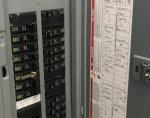luckylerado
Senior Member
- Location
- Lake of the Ozarks
NFPA 72 requires:
"10.6.5.4 Circuit Breaker Lock. Where a circuit breaker is the
disconnecting means, an approved breaker locking device
shall be installed."
My take has always been this means locked in the closed position. I have an inspector interpreting this to mean a lockout device must be installed on the breaker so as to lock the breaker out while servicing.
Thoughts? I do not see this requirement in NFPA 70. Is there any other reference that makes this more clear?
"10.6.5.4 Circuit Breaker Lock. Where a circuit breaker is the
disconnecting means, an approved breaker locking device
shall be installed."
My take has always been this means locked in the closed position. I have an inspector interpreting this to mean a lockout device must be installed on the breaker so as to lock the breaker out while servicing.
Thoughts? I do not see this requirement in NFPA 70. Is there any other reference that makes this more clear?


